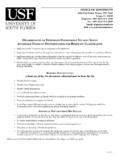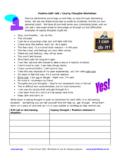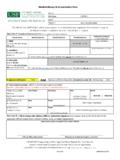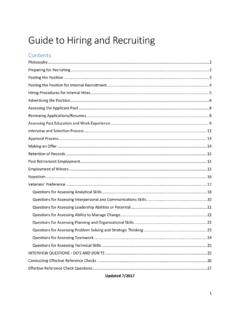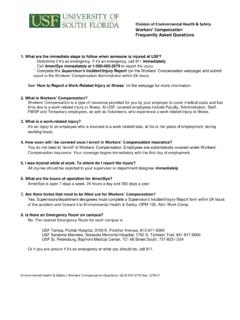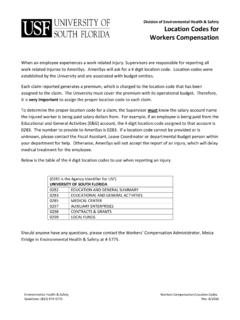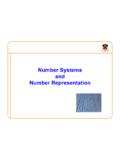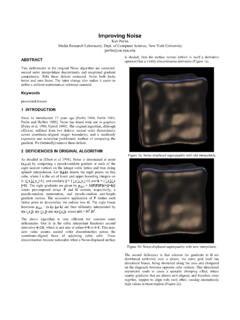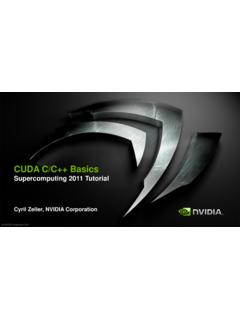Transcription of Math Definitions: Introduction to Numbers
1 math Definitions: Introduction to Numbers Word definition Examples Not Examples Natural Numbers The Numbers that we use when we are counting or ordering {1, 2, 3, 4, 5, 6, 7, 8, 9, 10, 11 ..} Whole Numbers The Numbers that include natural Numbers and zero. Not a fraction or decimal. {0, 2, 3, 4, 5 6, 7, 8, 9, 10, 11 ..} Integer A counting number , zero, or the negative of a counting number . No fractions or decimals {.. -3, -2, -1, 0, 1, 2, 3 ..} 2/3, , , Decimal number Any number that contains a decimal point or Rational Numbers Can be expressed as a fraction. Include integers and fractions or decimals 1/2 , 2/3 , 4/7, , Irrational Numbers Cannot be expressed as a fraction , 2 .. Positive Greater than 0. x is positive if x > 0. 1, 17, , , 18/3 0, -15, , -19/4 Negative Less than 0. x is negative if x < 0. -17, , -1981, - 0, 12, , , 892471 Non-Negative Greater than or equal to 0. x is non-negative if x 0.
2 0, 1, , 47812, 16/3, -11, , Non-Positive Includes negative Numbers and 0. Even An integer that is divisible by 2. 0; 2; -16; -8; 99837222 1; -7; ; Odd An integer that is NOT divisible by 2. 1; 7; 19; -17 0; 8; Place Value It is the value of where the digit is in the number . Examples are units, tens, hundreds, thousands, ten thousands, hundred thousands, millions,.. Equivalent Equal (=) and are equivalent Distinct Not equal. x and y are distinct if x y. 2 and 3 are distinct. 0 and 11 are distinct. and 3 are distinct. 4 and 4 are not distinct. and are not distinct. Constant A number that does not change Consecutive (Evenly spaced) In a row; without any missing; Numbers or objects are consecutive if none of them are skipped. 1, 2, 3, and 4 are consecutive integers. 4, 6, 8, and 10 are consecutive even integers. 2008, 2009, and 2010 are consecutive years. 3, 4, and 6 are not consecutive integers, because 5 was skipped.
3 math Definitions: Basic Operations Word definition Examples Simplify To make as short as possible 5 + 34 can be simplified to 2 Evaluate To solve for a certain value 5x + 3 evaluated for x = 2 gives us 13 Plus (Add) To increase a number by another number (+) 5 plus 2 = 5 + 2 = 7 Sum The result of adding (+) two Numbers . Also 5 is the sum of 2 and 3, since 2+3 = 5 Minus (Subtract, Difference) To decrease a number by another number (-) 6 minus 2 = 6 2 = 4 Difference The positive result of subtracting (-) two Numbers . The difference between 6 and 2 = 6 - 2 = 4 Fewer than To decrease by the original number (-) 5 fewer than 9 = 9 5 = 4 Multiply (Times) To add a number to itself a certain number of times (x or ) 3 times 4 = 3 4 = 12 Product The result of multiplying ( or ) two Numbers . 18 is the product of 6 and 3, since 6 3 = 18. Coefficient A number in front of, or multiplying, a variable. 4 is the coefficient of 4x Divide by To cut up a number into a certain number of smaller parts ( ) 8 divided by 4 = 8 4 = 8/4 = 2 Divided into To use a number to cut another number into smaller parts ( ) 3 divided into 12 = 12/3 = 4 Divisor The second number in a division; the number you are dividing by; the bottom number when division is written as a fraction.
4 In 8 4, the divisor is 4 Quotient The result of dividing ( or /) two Numbers . 6 is the quotient of 54 and 9, since 54/9 = 6. Numerator The top number in a fraction. The numerator of 6/7 is 6 Denominator The bottom number in a fraction. The denominator of 6/7 is 7 Reciprocal Switch the numerator and denominator of a fraction. The reciprocal of an integer n is the fraction 1/n. The reciprocal of 2/3 is 3/2. The reciprocal of 7 is 1/7. The reciprocal of 1/9 is 9/1, or just 9. Factor A number that can be added to itself to reach another number . x is a factor of y if y/x is an integer. 2 is a factor of 4 (since 4/2 = 2, which is an integer) Greatest Common Factor The largest factor that each number has. The greatest common factor of 24 and 36 is 12 Multiple The result when a number is added to itself. x is a multiple of y if x/y is an integer. 27 is a multiple of 3 (since 27/3 = 9, which is an integer) Least Common Multiple The smallest number that is a multiple of each number .
5 The least common multiple of 25 and 10 is 50 Prime A positive integer that is divisible by exactly two positive Numbers , 1 and itself. 1 is not a prime number , because it is divisible by only one positive number (itself). 2, 3, 5, 7, 11, 13, 17, 19, 23 .. Prime Factorization Reducing a number into only its prime factors. The prime factorization of 72 is 23*32 Power (Exponent, Base) An exponent tells you to multiply something by itself a particular number of times, in the same way that multiplication tells you to add something to itself a particular number of times. The number being multiplied by itself is called the base, and the number of times you multiply it is called the exponent or the power. Sometimes written as 2^5 2^5=25=2*2*2*2*2=32 In this case, 5 is the exponent and 2 is the base. We would say 25 out loud as two to the fifth power (or sometimes just two to the fifth ). Squared To square a number is to multiply it by itself.
6 A number x squared is written x2. Squaring a number means to raise it to the second power. 3 squared is 9, since 3 3=9. (-6) squared is 36, since (-6) (-6) = 36. Cubed To cube a number is to multiply it by itself three times. A number x cubed is written x3. Cubing a number means to raise it to the third power. 2 cubed is 8, since 2 2 2 = 8. Root The root of x is a number that when multiplied by itself a number of times will result in x. The number of times is the degree of the root. Another way to understand it is as an exponent that is a fraction. When the degree of a root is even, there are two solutions: a positive one and a negative one. If x is a negative number and the degree of the root is an even number , then there are no roots. The 3rd root of 8 = 81/3 = 8 = 2 The 2nd root of 25 = 251/2 = 25 = 5 or -5 The 2nd root of -4 = (-4)1/2 = 4 = no roots Perfect Square A number whose square root is an integer 64 is a perfect square because 64=8 Polynomial An expression with more than one algebraic term 4x3 + 2x2 + 6x + 3 Quadratic Equation An equation with a variable to the second power 3x2 + 8x + 2 = 0 Absolute Value The distance from 0.
7 Always positive |3| = 3 | | = |0| = 0 |-7| = 7 Inequality A relation between two values that are different instead of equal > means greater than < means less than means greater than or equal to means less than or equal to ( A way to express a range, but the point is not included 1 < x < 3 is the same as (1, 3) [ A way to express a range, but the point is included 1 x 3 is the same as [1, 3] Percent Another way of writing a fraction. x% is equal to the fraction x100. 50% is equal to 50/100, or 1/2. 75% is equal to 75/100, or 3/4. Average (Arithmetic Mean) The result of adding all Numbers and then dividing by the number of items. The average of 10 and 12 = 10+ 122 = 11 Median The middle number of an ordered number of items. Make sure to put the list in order first. If there is no middle number , take the average of the two Numbers in the middle. The median of 1, 10, and 11 = 10. The median of -1, 2, 0, 8, 4, 5, and 1 = the median of -1, 0, 1, 2, 4, 5, and 8 (ordered) = 2.)]
8 Mode The most common occurrence. There can be more than one mode if each occurs an equal number of times. The mode of 1, 2, 2, 3, 5, 5, 5 = 5 The modes of 1, 1, 2, 2, 4 = 1 and 2 Standard Deviation This is a measure of the spread of the data ( how far away it is from the mean) Ratio A relationship between two amounts. This shows how many times bigger one is over the other. The ratio should be in the same order as the words. Expressed with : A ratio can be simplified by dividing each side by the same number . Because of this, it doesn t always equal the actual number . If there are 12 blue cars and 3 red cars, the ratio of blue to red cars is 12:3 or 4:1 If the ratio of red to blue is 3:4, the actual Numbers of red and blue cars could be 3 and 4 or it could be 6 and 8, and so on. Proportion When two ratios are equal 43=8 If the ratio of blue cars to red cars is 4:3, how many red cars are there if there are 8 blue cars?
9 math Definitions: Geometry Word definition Examples Point One single location. Usually a Line Connects two points and continues forever in both directions Ray Starts from one point and continue forever in only one direction Line Segment Connects two points but does not continue beyond those points Endpoint The end of a line segment or ray Midpoint The point on a line that is of exactly equal distance from both endpoints Angle The space between two intersecting lines. Usually measured in degrees or radians Degree of an Angle The measurement of an angle. Usually between 0 and 360 Right Angle An angle with a measure of 90 Acute An angle with a measure of less than 90 Obtuse An angle with a measure of more than 90 Complementary Two angles whose sum is 90 Supplement Two angles whose sum is 180 Bisect To cut an angle or line exactly in half Tangent To touch at only one point Parallel Two lines that never touch Perpendicular Two lines that touch and form four 90 angles To Scale When a picture is drawn as it looks.
10 If something is not drawn to scale, it might not correctly represent the actual picture. Polygon An enclosed figure with 3 or more lines Vertex Where two lines of a polygon touch Quadrilateral A four-sided polygon. The sum of interior angles is 360 Parallelogram A four-sided polygon such that opposite sides are parallel Rhombus A four-sided polygon such that all sides are equal and such that opposite angles are equal Rectangle A four-sided polygon such that opposite sides are equal, such that opposite sides are parallel, and such that all angles equal 90 Square A four-sided figure such that all sides are equal, such that opposite sides are parallel, and such that all angles equal 90 Trapezoid A quadrilateral with two sides that are parallel Triangle A three-sided figure. The sum of interior angles is 180 Isosceles Triangle A triangle with 2 equal sides. The angles opposite the equal sides are equal.
